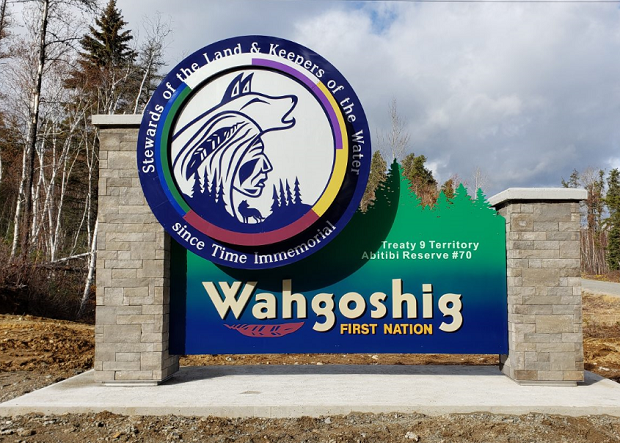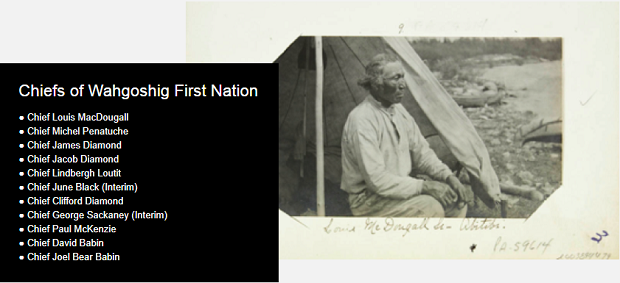Wahgoshig First Nation
About Us

Since time immemorial, the people of Wahgoshig First Nation have lived and thrived in the Abitibi region. Formerly known as Abitibi Band of Abitibi Indians, Wahgoshig First Nation is an Algonquin community whose traditional territory straddles a large segment of Northeastern Ontario and Northwest Quebec. The Wahgoshig people were known centuries ago as a nomadic group of hunter-gatherers, and the majority of our members have Algonquin or Cree descent. Our codes, customs, and culture are reflective of our Peoples.
ARRIVAL OF SETTLER EUROPEANS
When the settler Europeans arrived to this land in the 1600’s, the Indigenous Peoples and the British Crown began to enter into land agreements. The Abitibi Indian Reserve No. 70 was created when the James Bay Treaty (Treaty 9) was signed at the Hudson's Bay Company post on Lake Abitibi in Quebec on June 7, 1906.
When the Crown’s Treaty Commissioners arrived at the Hudson's Bay Company post on Lake Abitibi in Quebec on June 7, 1906, they only met with the Indians located within Ontario, not the Indians in Quebec. The Abitibi Indians hunted on both sides of the border and wanted to talk with the Commissioners together; they did not want to be separated. It was also believed that the Treaty 9 discussions were with the Crown and not with the provincial government, therefore both Ontario and Quebec hunters could participate. But at this time, the Commissioners told the Quebec Indians that the the Treaty talks had no authority from the Quebec and would only talk with the Ontario Indians. The Commissioners said they would try to see if the Quebec government would allow them to return later to talk about setting aside reserve land for the Quebec hunters.
The terms of the Treaty were accepted at the Treaty conference with the Ontario based Abitibi Indians; the Ontario reserve land was identified; the annual payments were agreed to; and an election was held which resulted in Louis MacDougall, Jr., as chief, with Michel Penatuche and Andrew MacDougall as councillors.
The Quebec Indians had a hard time getting the Quebec government to set aside reserve land for their people. So, two years after the signing of the James Bay Treaty the federal government then arranged to have the Quebec Indians included in Treaty 9. Part of this arrangement meant the Quebec Indians would receive annuities and would share in the revenues allocated to Abitibi #70.
The governmental body responsible for the affairs of the Abitibi Indians have changed since the signing of the Treaty. From 1906 to 1972 the Department of Indian Affairs in Quebec was responsible for the affairs of both the Abitibi-Dominion Band of Abitibi Indians (located in Quebec) and the Abitibi-Ontario Band of Abitibi Indians #70. In 1972 and onwards, Indian Affairs in Sudbury, Ontario, took over the affairs of the Abitibi-Ontario #70 band. In 1979, the Abitibi-Dominion Band changed its name to Abitibiwinni First Nation, located in Quebec, and the Abitibi-Ontario Band became Wahgoshig First Nation. The reserve land that promised was in 1906 was 19,239 acres or 78 km2 . But the land wasn’t Wahgoshig’s until 1986. At that time, the members were living off the land in tents within their traditional territory. Since receiving its reserve land in 1986, Wahgoshig has grown and become stronger with a collective desire to grow even more into a healthy community.
Wahgoshig First Nation Leadership
Despite challenges, past community members, Chiefs, Councils, and Band staff have done tremendous work in developing the community into what it is today. Wahgoshig has asserted its treaty and Indigenous rights; developed businesses and new revenue streams; created codes and policies; and built houses, roads, infrastructure, and band buildings. Each Chief and Council has worked towards the benefit of the community and provided a solid foundation for the next Chief and Council to continue to build on.

Location of Wahgoshig First Nation
Wahgoshig First Nation (7770.1 hectares) is situated in the District of Cochrane at latitude 48 degrees 44' - 48 degrees 33' West and longitude 79 degrees 58' - 80 degrees 01' North. The signing of the James Bay Treaty 9 on June 7th, 1906 created the reserve Abitibi No. 70. Highway 101 provides access to 5.8 km long reserve road, approximately 50 km east of Matheson, Ontario, within a few miles of the western Quebec border. The north end of the reserve meets the south shore of Abitibi Lake, which separates the two provinces.
The community where all the on-reserve members reside occupies about 25 hectares of the 70 hectares of flat land adjacent to, and east of, Blueberry Lake.
REGISTERED POPULATION
On Reserve: approximately 150
Off Reserve: approximately 180
Total: approximately 330
LAND BASE
Wahgoshig First Nation is approximately 7771 hectares in size. The north shore of the reserve meets the south shore of Lake Abitibi.
HOUSING
There are approximately 60 homes on Wahgoshig First Nation.
EMERGENCY SERVICES
Wahgoshig First Nation support their own Fire Department and equipment, and a First-Response Team.
COMMUNITY INFRASTRUCTURE
- Power supply through Hydro grid
- Communal water system
- Water treatment facility
- Health Clinic
- Landfill
- Fire Department
- Community Centre
- Education Centre
- Playground/park
- Boat Launch
Human Resources Administrator
The position of the Human Resources Administrator is responsible for ensuring that the overall administration, coordination, and evaluation of human resources plans and programs are realized.
Personal Support Worker
The position of the Personal Support Worker is responsible for people who are ill, elderly or need help with daily tasks at Wahgoshig First Nation.